Ready for the next big ‘Comet of the Century?’ Yeah, us too. Cometary apparitions are the big unknown in backyard astronomy, an eternal uncertainty in the clockwork goings-on of the universe.
Sure, there are no bright comets on the horizon currently, but there are a grab bag of binocular and telescopic ones to watch out for this month, including a surprise actor and an unusually close pass of a comet near the Earth.
First up is 252P/LINEAR. Over the past week, this periodic comet jumped a 100-fold in brightness, from +11th to 6th magnitude. That makes it a fine binocular comet that’s knocking on naked eye visibility from a dark sky site. The bad news (for us up north, at least) is the comet currently resides deep in the southern hemisphere around declination -71 degrees south in the constellation Mensa. That southern plunge will deepen, as the comet passes less than three degrees from the southern celestial pole on March 19th.
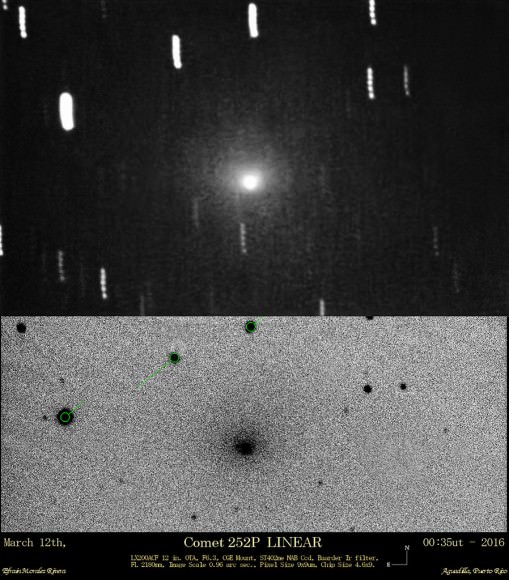
Will 252P/LINEAR keep up its outburst as it moves northward? One advantage as it passes near Earth is that the comet will really be truckin’ at a whopping 10 degrees per day—that’s nearly the span of a Full Moon every hour—at its closest approach. 252P/LINEAR reached perihelion 0.9961 AU from the Sun on March 15th, 2016, and passes 13.9 lunar distances (5.4 million kilometers) from the Earth on March 21st. We might just get first views from up north soon, ‘if’ 252P/LINEAR keeps up its brightening act. The comet will enter the constellation Scorpius next week on March 25th, and crosses the plane of the Earth’s orbit known as the ecliptic northward on March 28th. This would put Comet 252P/LINEAR low to the south for observers based in mid-northern latitudes just after local midnight, and transiting the local meridian a few hours before dawn.
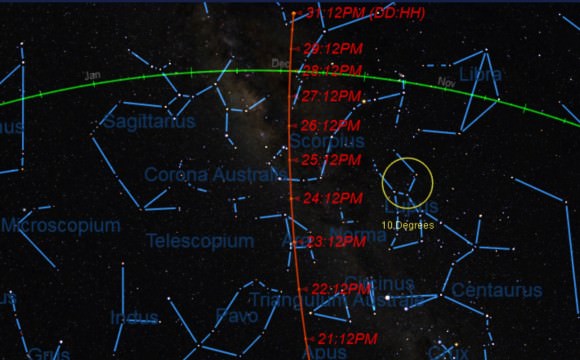
The waning gibbous Moon also passes within a degree of the comet on the morning of March 30th, and actually occults it for viewers based in Antarctica. And yes, we’ll have to contend with a brilliant Moon, which reaches Full on March 23rd. Too bad the penumbral eclipse won’t help to dim the Moon much…
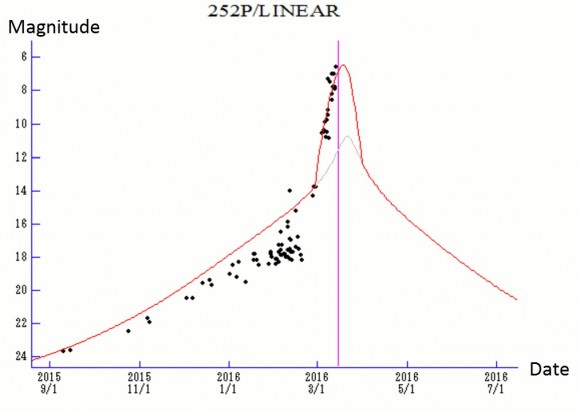
What’s the first date that you can spot it from your latitude? We’ll be watching each clear morning from here in southern Spain at latitude 37 degrees north, and will tweet out our first positive sighting (we’re @Astroguyz).
Comet 252P/LINEAR may have an interesting tale to tell. Discovered on April 7th, 2000, this comet is a relative newcomer to the inner solar system. In fact, the comet seems to have been thrown into its short 5.33 year orbit in just the last few centuries, mainly thanks to several close passes near Jupiter.
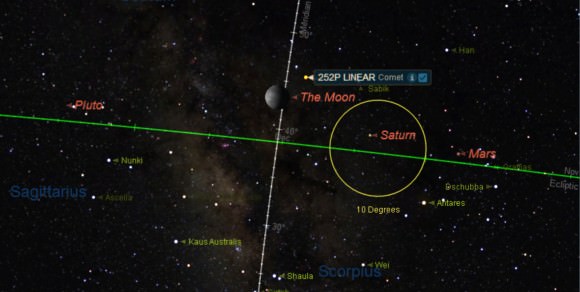
And Comet 252P/LINEAR has company. On January 21st, 2016, astronomers noted that asteroid BA14 PanSTARRS not only shares some orbital characteristics with 252P/LINEAR, but is actually cometary in nature as well, with a hazy coma and spiky tail. Comet BA14 PanSTARRS is most likely a tiny fragment related to 252P/LINEAR, no more than 60 to 200 meters in size. BA14 PanSTARRS also passes only nine times the Earth-Moon distance from our planet on March 22nd.. This close shave is the second closest known passage of a comet from the Earth in the history of observational astronomy. Unfortunately, its tiny size means the comet is only expected to reach magnitude +12 as it glides northward through the constellation Cancer on the night of March 22nd.
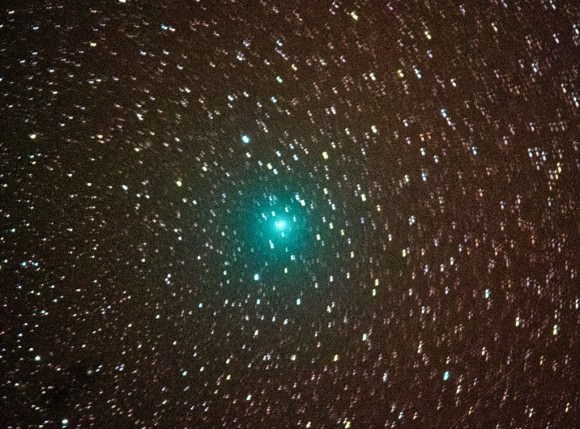
Comet 252P/LINEAR ranks as the 5th closest recorded passage of a comet near Earth, while BA14 PanSTARRS takes second place. And the closest known passage of a comet near Earth of all time? That would be Comet D/1770 L1 Lexell, which passed 2.2 million kilometers (less than six lunar distances) from the Earth on the night of July 1st, 1770.
Older amateur astronomers will also remember the close (4.7 million kilometer) passage of the former second place holder, Comet IRAS-Araki-Alcock in May 1983. I was a high school freshman at the time, and I managed to grab sight of the comet one clear night in northern Maine with my 60mm refractor.
The good folks over at the Virtual Telescope project will also feature live views of Comet BA14 PanSTARRS as it makes its historic passage by the Earth on the night of March 21st starting at 22:00 UT/6:00 PM EDT. Hosted by astronomer Gianluca Masi, it promises to be quite a show!
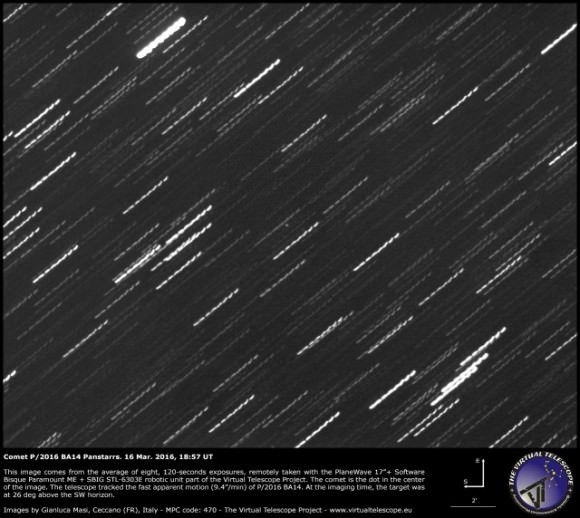
Finally, we wanted to give Comet 332P/2015 Y2 Ikeya-Murakami an honorable mention. Discovered on November 3rd 2010, this short period comet orbits the Sun once every 5.4 years. This comet also gave astronomers a start back in early January of this year, when it fragmented into at least four pieces. Though faint, this comet is worth keeping a telescopic eye on, as it’s well-placed for northern hemisphere observers throughout 2016, though currently only shining at magnitude 17.
There are comets galore, though a vast majority of them are so faint that they’ve eluded detection, right up until modern times. Comet BA14 PanSTARRS would’ve probably passed by unnoticed even a decade ago, and even 252P/LINEAR would have evaded observation before the age of the telescope.
And just look at the wealth of sungrazers discovered courtesy of the Solar Heliospheric Observatory (SOHO). Before its launch in 1995, less than a half-dozen true sungrazing comets were known; SOHO’s tally now sits at an amazing 3,000+ and counting.
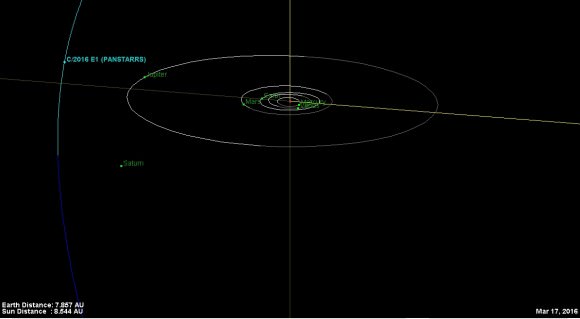
We’re looking at the Minor Planet Center’s listing daily for possible new finds. In fact, the recent discovery C/2016 E1 PanSTARRS sparked an interesting discussion. Though the comet isn’t the next ‘big one,’ it is notable in that it reaches perihelion out in the regime of Saturn’s orbit at 7.9 AU… @DunlapObservatory noted on Twitter that the former record holder for the most distant perihelion was C/1974 V1 Van den Bergh at 6.02 AU, so this record may no longer be so…
Any comet historians out there know if this new record holds true?
Certainly, there are lots of things left to discover out there in our own cosmic backyard, passing by unheralded right under our noses.

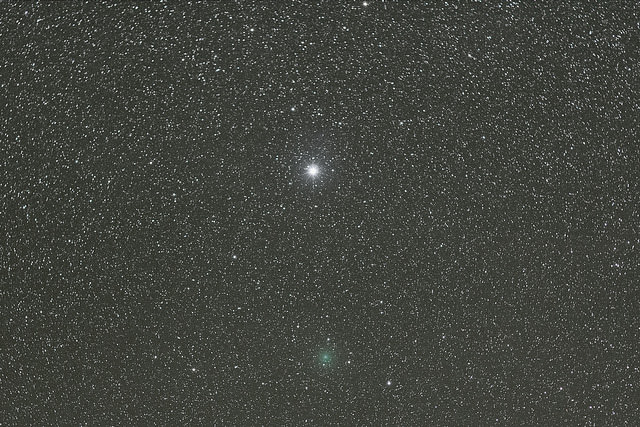
APOD features it today with a great pic taken yesterday from down under
http://www.universetoday.com/127774/comet-252p-linear-and-ba14-panstarrs/
doh, it’s
http://apod.nasa.gov/apod/ap160317.html
I captured a shot of P252/Linear at 4AM on 3/26/2016 from Los Angeles . The picture is posted in dpreview.com in the astrophotography forum.
hha